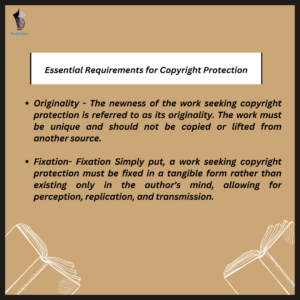In today’s digital age, where creative works are easily accessible and shareable, it becomes crucial to understand the concept of copyright and its role in protecting intellectual property. In India, the Indian Copyright Act of 1957 provides the legal framework for copyright protection. This article aims to shed light on what copyright is, the scope of protection it offers, and the essential requirements to obtain copyright under the Indian Copyright Act.
What is Protected?
The copyright law, as its name implies, grants only the owner/author of the work the right to reproduce and profit economically from its use. In common parlance, the proprietor of a copyrighted work can prohibit others from copying his work for any purpose (with few exceptions) without his permission, which is typically granted in exchange for royalties from the person using the copyrighted work. Copyright can be conferred for any creative or laboriously produced work. It can be granted to literary works, cinematographic works, music, paintings, dance choreography, software, and many other types of creations. Copyright protection is activated immediately upon the creation of a work, but registration gives the copyright holder the upper hand in matters of infringement and commercialization.

The Indian Copyright Act, 1957 governs copyright law in India. It is critical to recognise that copyright law protects the expression of ideas rather than the ideas themselves. Many people may have similar ideas, but the expression or execution of those ideas must differ from person to person, and this is what copyright law protects.
For example, a reality show is an idea in which a few candidates are chosen and then eliminated one by one until a winner is determined. The expression of the idea will determine if such a show is a singing reality show, a dancing show, or a cookery show.
In the case of R.G. ANAND V. DELUXE FILMS, which was the determining case for this idea-expression dichotomy in India, the Supreme Court held that copyright does not protect ideas, subject matter, themes, storylines, or historical/legendary facts. When the structure, style, organisation, or presentation of these aspects is duplicated from the original work protected by intellectual property rights, this constitutes an infringement.
The Essential Requirements
As previously stated, the copyright law protects all types of creative works, but in order to obtain the copyright, two basic characteristics must be met: originality and fixation. Let us examine each in depth –
Originality – The newness of the work seeking copyright protection is referred to as its originality. The work must be unique and should not be copied or lifted from another source.
Section 13(1) of the Indian Copyright Act 1957 states that copyright subsists in “original literary, dramatic, musical and artistic works.” Notwithstanding, the Act omits to provide any delineation or criterion for ascertaining the originality of a piece of work. The responsibility of determining the level of originality necessary for a work to be eligible for copyright protection falls upon the court. The criteria for determining originality may vary across jurisdictions and legal systems.
UK’s Sweat of brow doctrine – This doctrine stipulates that an author’s work is eligible for copyright protection even if they have only fulfilled the minimum requirements in its creation. This doctrine prioritises skill and labour over creativity, such that a work may be eligible for copyright protection if the author has invested significant effort and diligence in its creation.
USA’s Modicum of Creativity – This theory necessitates a certain level of originality in addition to the author’s talent and labour. However, it does not indicate how much creativity is required or judged good enough to obtain copyright.

INDIA’s doctrine of Merger – The merger doctrine is just the combination of the two described above. In India, originality is measured by more than just skill, effort, or ingenuity. To pass the originality test, creativity, skill, and work are all required.
Fixation – Fixation Simply put, a work seeking copyright protection must be fixed in a tangible form rather than existing only in the author’s mind, allowing for perception, replication, and transmission. Consider the following example: a song. When a songwriter writes the lyrics on paper, the paper becomes the tangible medium in which the song is fixed. It can be read, copied, and distributed to others. Similarly, when a computer programme is placed in memory, it becomes fixed. It satisfies the fixation criterion whether it is saved on a hard disc or briefly resides in the computer’s RAM during execution.
Finally, if both of these criteria are met, the creator or owner of the work might be given copyright. Once granted, a copyright is valid throughout the
Conclusion
Copyright protection is of utmost importance in today’s creative landscape. It provides creators with exclusive rights to their works, enabling them to control how their creations are used, reproduced, and distributed. By safeguarding their intellectual property, copyright protection incentivizes creativity, innovation, and artistic expression. It ensures that creators are recognized and rewarded for their efforts, fostering a vibrant cultural and economic ecosystem. Copyright protection also encourages the dissemination of knowledge and information, as creators feel secure in sharing their works without fear of unauthorized exploitation. Ultimately, copyright protection plays a vital role in preserving and promoting creativity while fostering a fair and balanced environment for creators and users alike.
#copyrightlaw #indiancopyrightact #originality #fixation #ideaexpression #ipr


